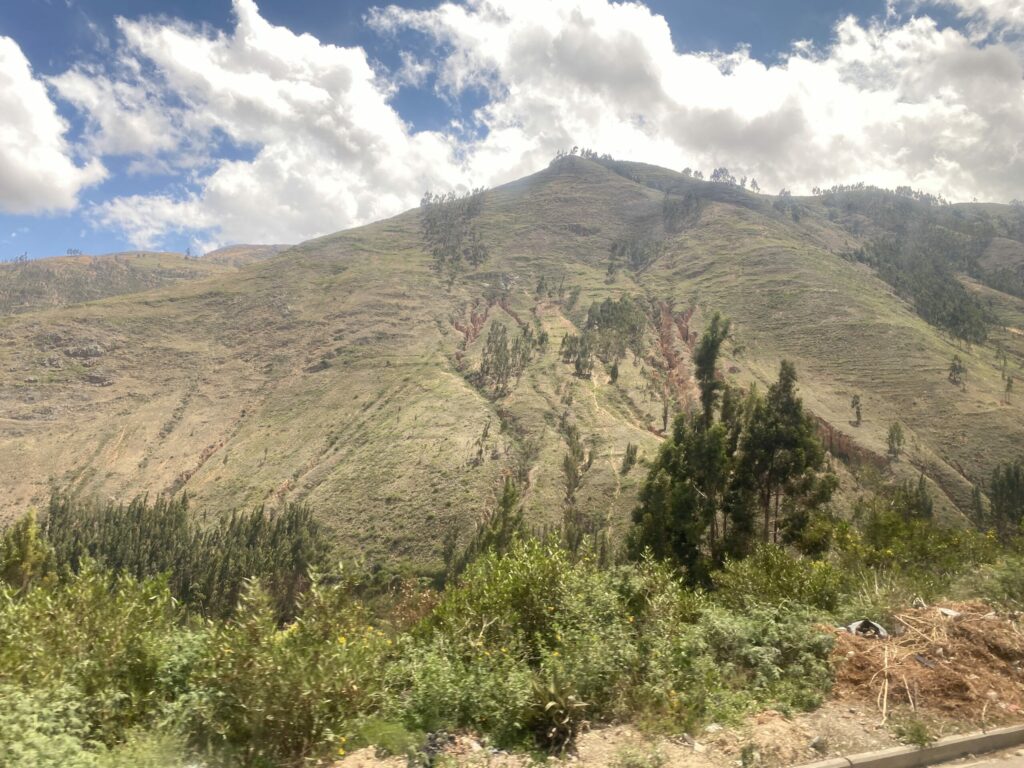By Madelon Eelderink, founder of SevenSenses
This blog was created during the Ecosystem Restoration Design training that Madelon attended in 2024 and is part of the PAO blog series for ecosystems, in which she shares her views on how PAO can contribute to ecosystem restoration and more.
In January 2022, I travelled in Peru from the Andes highlands to the Amazon region, by bus. Locals said the travel would be beautiful as the landscape becomes greener and greener, going from well over 3000 meters height all the way downhill. I was super excited to go to the Amazon jungle, as I remembered from earlier travels how happy the lush forests used to make me feel. However, the landscape did not become the type of ‘greener’ I had hoped for. For as far as I could see, there were only huge expanses of agricultural fields without any trees or other natural vegetation. I shushed myself with the thought ‘we just need to get some further into the amazon’, but even though on the map it looked like we were far into the Amazon rainforest, it did not look like it at all. Locals say ‘but on the other side of the mountain there is still forest’ but on the other side of the mountain they say the same thing. It made me feel incredibly sad and worried. The Ecosystem Restoration Design course triggered some ideas on possible causes of the degraded landscape and what Participatory Action Research (PAR) could contribute to addressing the complexity of deforestation and creating ownership among stakeholders to tackle the root causes of deforestation.
The problem of deforestation in the Peruvian Amazon
When it comes to causes of the massive deforestation and degradation, the course brought me to the following possibilities (that need further research, though). First, cutting trees gives fertile land, so to farmers it makes sense to clear forest where they can (i.e. slash and burn activities), cultivate a few crops and move on to the next piece of land once soil fertility is too low. The agricultural fields I saw in the Peruvian Amazon are large, so I presume we are not talking about smallholder farmers here. It could be that the government stimulates farmers to become bigger by providing subsidies for machineries or free fertilizer. I saw only monocropping, probably because it makes economically sense for a farmer to produce and sell many of the same crops. Finally, if these farmers don’t own the land themselves, they will not be interested in investing energy in planting trees or other long-term efforts. Often I see or hear about dedicated nature lovers who work their asses off trying to convince local stakeholders of the importance of nature, leading to great deception when they are not being heard. The thing is, it is not about convincing people. It’s about hearing all different perspectives (also the ones you might not want to hear) and allowing local stakeholders to co-create solutions based on those perspectives. That’s where Participatory Action Research (PAR) comes in.
Creating ownership to tackle deforestation
To address the problem of deforestation through PAR, the PAR practitioner first needs to orient him/herself to fully understand the current situation. For example, how is land tenure organized? What does the law, rules and regulations (also the informal ones) say? You would also need to further investigate the climax biome, weather patterns, quality of the soil etcetera. Of equal importance, local stakeholders such as the farmers and their families, wholesalers, landowners, local governmental bodies, agroforestry experts et cetera need to be interviewed individually. We need to know their view on the current situation, their desired situation and needs, and what assets (e.g. abundance, manpower, things that go well) and solutions they see. In the same interview, it is important to gain insight in what motivates them to do what they love to do and to learn about their deepest values. That’s what we call System Exploration: the entire system (and all perspectives on the system) in which the problem of deforestation is embedded is being explored.
Once you have all their individual perspectives, you create an overview of their ‘shared truth’ and invite them to come together to reflect on this shared truth. Next, you organize new brainstorm sessions to facilitate them in finding solutions that all of them would benefit from, including nature of course (nature is a stakeholder too!). The agroforestry experts could help think along how to improve the agricultural landscape. I believe that in that way, a sense of ownership is developed among the stakeholders that motivates them to make the execution of their solution(s) a success.
And hopefully, when you travel from the Peruvian highlands to the Amazon region one day, you will see a beautiful lush agroforestry landscape!
Join our trainings!
Want to learn more about Participatory Action Research, for either ecosystem restoration or other complex problems? Join the SevenSenses PAR Practitioners Program!
Rather read more about PAR first? Order my handbook Participatory Action Research (in Dutch) here.
I’m curious to your experiences, let me know!
Madelon
Also read the other blogs in this ‘PAO for ecosystems’ series:
Ecosystem restorers: here’s how to get locals ‘on board’
What Cows Can Teach Us About Sustainable Change
And more will follow!

